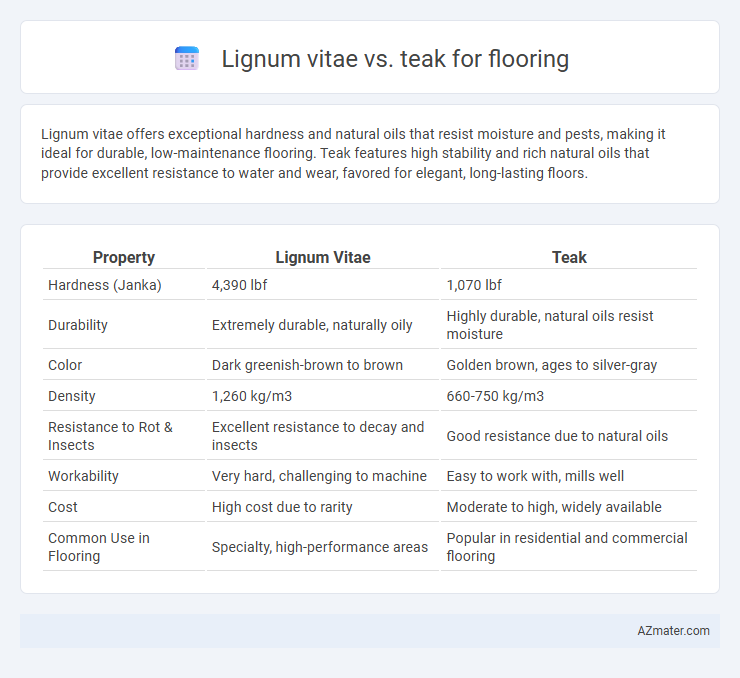Lignum vitae offers exceptional hardness and natural oils that resist moisture and pests, making it ideal for durable, low-maintenance flooring. Teak features high stability and rich natural oils that provide excellent resistance to water and wear, favored for elegant, long-lasting floors.
Table of Comparison
| Property | Lignum Vitae | Teak |
|---|---|---|
| Hardness (Janka) | 4,390 lbf | 1,070 lbf |
| Durability | Extremely durable, naturally oily | Highly durable, natural oils resist moisture |
| Color | Dark greenish-brown to brown | Golden brown, ages to silver-gray |
| Density | 1,260 kg/m3 | 660-750 kg/m3 |
| Resistance to Rot & Insects | Excellent resistance to decay and insects | Good resistance due to natural oils |
| Workability | Very hard, challenging to machine | Easy to work with, mills well |
| Cost | High cost due to rarity | Moderate to high, widely available |
| Common Use in Flooring | Specialty, high-performance areas | Popular in residential and commercial flooring |
Introduction to Lignum Vitae and Teak Flooring
Lignum vitae flooring is renowned for its exceptional density, natural oils, and remarkable durability, making it highly resistant to wear, rot, and insect damage. Teak flooring is prized for its rich golden-brown color, natural water resistance, and stability, which ensures minimal warping or shrinking over time. Both hardwoods offer excellent longevity and unique aesthetic appeal, making them premium choices for interior or exterior flooring applications.
Botanical Origins and History
Lignum vitae, derived from the Guaiacum genus native to the Caribbean and northern South America, has been revered for centuries due to its exceptional density and natural oils that resist decay. Teak, sourced from Tectona grandis trees predominantly found in Southeast Asia, holds a rich maritime history for its durability and water resistance, making it a preferred material in shipbuilding and flooring since ancient times. Both hardwoods exhibit unique botanical traits that influence their longevity and aesthetic appeal in flooring applications.
Physical Properties and Hardness
Lignum vitae is one of the hardest and most durable woods, with a Janka hardness rating around 4,500 lbf, making it exceptionally resistant to wear and impact, ideal for high-traffic flooring. Teak, with a Janka hardness of approximately 1,070 lbf, offers a balance of strength and workability, notable for its natural oils that enhance moisture resistance and durability. Both woods have excellent density, but Lignum vitae's superior hardness and natural oils make it more suitable for environments requiring maximum toughness, whereas teak excels in stability and weather resistance.
Durability and Longevity Comparison
Lignum vitae offers exceptional durability due to its extreme hardness and natural oil content, making it highly resistant to wear, rot, and insect damage, which significantly extends its lifespan in flooring applications. Teak, while also known for its durability and natural oils, provides good resistance to moisture and decay but is generally softer than Lignum vitae, resulting in a slightly lower wear resistance. For flooring, Lignum vitae's superior hardness and natural protective properties contribute to a longer-lasting surface, whereas teak balances durability with a more manageable workability and aesthetic appeal.
Resistance to Moisture and Decay
Lignum vitae stands out for its exceptional natural oils and density, providing superior resistance to moisture and decay, making it ideal for moist and high-wear environments. Teak also offers excellent moisture resistance due to its high oil content and natural silica, which helps prevent water absorption and fungal growth. While both woods provide durability, lignum vitae's higher density and natural resin make it more resistant to decay and wear over time in flooring applications.
Aesthetic Appeal and Color Variations
Lignum vitae boasts a rich, deep greenish to brown hue with natural oils that create a lustrous, polished finish ideal for luxurious flooring. Teak offers a warm golden-brown color that darkens elegantly over time, providing a classic and versatile aesthetic. Both woods showcase unique grain patterns and color variations that enhance the visual texture and appeal of any flooring project.
Installation and Maintenance Requirements
Lignum vitae flooring demands meticulous installation due to its extreme density and hardness, often requiring specialized tools and professional expertise to avoid damage. Teak offers easier installation with its moderate hardness and natural oils, which also provide resistance to moisture and pests, reducing maintenance efforts. Both hardwoods require periodic cleaning and occasional resealing, but Lignum vitae's natural oils enhance durability, making it more resistant to wear but challenging to refinish compared to teak.
Environmental Impact and Sustainability
Lignum vitae flooring offers exceptional durability and natural oil content, reducing the need for chemical treatments and extending its lifespan, which supports sustainable use in high-traffic areas. Teak, widely praised for its natural resistance to pests and moisture, often comes from managed plantations, contributing to environmentally responsible sourcing, though concerns remain about illegal logging in some regions. Choosing either wood requires verifying certification such as FSC to ensure compliance with sustainable forestry practices and minimize deforestation impacts.
Cost and Availability
Lignum vitae is significantly more expensive than teak due to its rarity and slower growth rate, making it less available in the market. Teak offers a more cost-effective option for flooring with widespread availability, thanks to its faster growth and extensive plantations. Both woods provide durability, but teak's affordability and accessibility make it a popular choice for budget-conscious flooring projects.
Choosing the Best Wood: Lignum Vitae vs Teak
Lignum Vitae offers exceptional hardness and natural oils that enhance durability and resistance to wear, making it ideal for high-traffic flooring. Teak provides excellent stability and water resistance due to its high oil content, ensuring long-lasting performance in humid environments. Selecting between Lignum Vitae and Teak depends on desired hardness, maintenance level, and exposure to moisture in flooring applications.

Infographic: Lignum vitae vs Teak for Flooring
 azmater.com
azmater.com